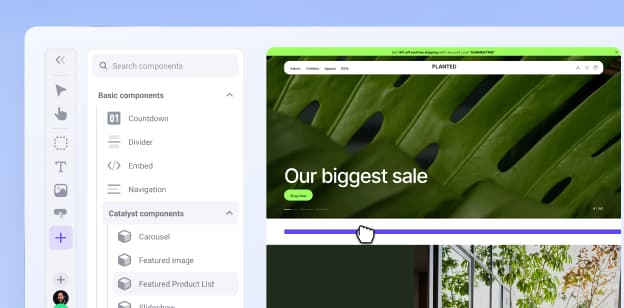by Brett Regan
Henry Ford reimagined the automotive sector with the conveyor belt. Jacob Davis and Levi Strauss persuaded the world to wear durable denim over wool and textile. Today, top brands are honing their fully automated smart factory solutions.
These visionary leaders have challenged the status quo and ignited a true revolution in the manufacturing industry.
But amid rapid changes in production, some manufacturers, especially in the B2B (business-to-business) space, may be overlooking the need for digital transformation, as B2B buyers now expect online experiences that mimic those of B2C ecommerce.
This is where manufacturer ecommerce comes into play.
A manufacturer is a company that produces goods for sale from raw materials and sells them to customers, wholesalers, or distributors. Thus, manufacturer ecommerce is specifically geared toward manufacturers and distributors, addressing their specific business needs and working to make processes and workflows more efficient.
Manufacturing companies are now seeking a top B2B ecommerce platform to help boost online sales and meet a new wave of customer expectations.
The shift for B2B manufacturer buyers
The global pandemic cast a heavy toll on manufacturing companies.
In response to major supply chain disruptions and widespread uncertainty, manufacturers sought leaner ways of operating, procuring, and purchasing supplies from others. But above all, the industry saw a huge lean toward digital commerce.
So while the customer base might have looked the same, the B2B buyer journey shifted.
The days of relying solely on B2B sales teams are over. Today, the journey is a mix of physical and digital interactions that result in an online purchase.
“The way B2B buyers shop is changing, and B2B merchants need to adapt,” Lance Owide, B2B General Manager at BigCommerce, said. “Buyers are turning to online channels to research, compare, and purchase products. B2B merchants need to have a strong online presence and offer a seamless omnichannel shopping experience to keep buyers loyal and converting, or risk losing market share.”
Given such an array of demands and need for digital channels, an integrated ecommerce strategy is a manufacturer’s best bet for delivering the user experience their customers desire.
A New Approach for New Expectations
BigCommerce’s B2B ecommerce platform enables you with powerful features to readily meet — and exceed — your buyers’ expectations.
Benefits of manufacturers having an ecommerce website
Given the acceleration of B2B ecommerce, launching an ecommerce business makes sense profit-wise. However, there are several more benefits beyond monetary gains:
Direct access to customers.
The perks of the direct-to-consumer (DTC) business model are well known among B2C brands, but there are also several benefits for B2B manufacturers that sell through their ecommerce website over distributors:
Preserving higher profit margins
Strengthening customer relationships and capturing data about their needs and preferences
Exerting greater control over brand representation
Ensuring optimal pricing and discount strategies
Collecting customer data for personalisation
Increasing customer loyalty through on-brand retention campaigns
Opportunities to innovate.
By knowing how consumers shop and what they value in their suppliers, you can develop unique value propositions. For example, feedback from equipment end users can tell you which add-ons or modifications to prioritise.
Procurement data can suggest when certain parts are due for replacement so that you could pitch an early delivery to the buyer. Feedback from sales reps and support agents can suggest how you can improve after-sales services, such as introducing better delivery schedules, improving warranty, or expanding the scope of installation/training services.
Scalability.
Ecommerce greatly increases your bandwidth for processing orders without the need to attract more distributors or hire extra sales reps. Items that don't need any customisation can be instantly sold to the buyers without in-person contact.
What's more, you can seamlessly tap into new markets and attract new customers.
Search engines can play a huge role in how new customers will find your website. Thus, enhancing your search engine optimisation (SEO) and having a strong online presence is crucial to attracting new customers and establishing a competitive advantage.
Improved efficiency.
Because orders are processed digitally, buying efficiency and effectiveness can be improved for manufacturers and other types of B2B sellers.
By using an ecommerce platform, you’ll be able to automate time-consuming manual processes, such as checkout, billing, and inventory management.
As a result, you can devote time and resources to other core business activities, such as marketing and customer support.
Sell your complete product catalogue.
As a manufacturing company, you likely have a large number of products, including personalised products, that vary in price depending on the customer and segment. Plus, you’ll want to offer personalised product suggestions to prospective customers to help increase conversions.
With an ecommerce platform, you can cover both of these bases, syncing your entire catalogue to your website and configuring prices as needed.
BigCommerce, for example, is built for big catalogs. In fact, merchants can add up to 600 SKUs per product. Plus, our platform makes it easy for hybrid businesses with both B2C and B2B customers to offer different price lists or catalogues to customer groups.
Brand awareness.
In addition to your digital marketing and social media efforts, you can SEO-optimise your ecommerce website to receive traffic from search engines for both types of queries — product and brand-name ones — so that more buyers get familiar with your brand and full product range.
Luckily, many ecommerce platforms provide built-in SEO tools to help make your life easier. BigCommerce, for example, offers several SEO tools right out of the box, such as optimised URLs, unique URLs, microdata, a content delivery network as well as 301 redirects and URL rewrites.
Free B2B Masterclass
Want to grow B2B online sales faster? Start now by enrolling in our free B2B Masterclass..
How to effectively use ecommerce for manufacturers
B2B customers have an array of sales channels to choose from — distributors, channel partners, online marketplaces, resellers. The main goal for a manufacturing business is to provide an easier purchasing experience for them via ecommerce.
Create an engaging website.
By revamping your digital presence and offering a B2C experience for your B2B buyers, you’ll be able to transform a non-transactional, static website into one that is transactional and interactive.
Try integrating elements such as videos, educational resources, self-service functionality, and specific pricing to help engage customers and keep them returning to your online store for more.
On top of that, it is vital to have a frictionless and secure checkout process in order to enhance the online ordering experience.
Provide a personalised catalog.
Today, B2B retailers can harness ecommerce’s ability to customise experiences and give shoppers what they want in the shortest amount of time.
For example, ecommerce sites can provide product recommendations based on customer data — such as geo-location or demographic — which can lead to a significant increase in conversion rates and a decrease in cart abandonment. Try making recommendations for complementary products based on what product page the customer is browsing or their order history.
Or, consider implementing a quick reorder option. BigCommerce B2B Edition, for example, offers a Quick Order Pad that gives customers an easy way to quickly reorder products.
Real-time product information.
One of the greatest conveniences of shopping on B2C sites is the ability to view detailed product information and real-time inventory updates.
Take Amazon, for example. Anyone can search for an item and easily access its dimensions, available colours, materials, and pricing, as well as whether or not the product is in stock.
As real-time product information becomes the norm within the B2C space, it’ll be no surprise if B2B customers expect the same functionality on B2B ecommerce sites, too.
Luckily, some ecommerce platforms offer PIM and ERP software that can aid merchants in managing real-time product information and inventory updates. BigCommerce, for instance, offers ERP integrations such as Feedonomics to track sales orders, fulfilment, inventory management, warehouse management, replenishment, and more.
Sell on marketplaces.
With 65% of B2B buyers purchasing from a marketplace, connecting your ecommerce platform to online marketplaces should be a no-brainer.
Many commerce platforms like BigCommerce integrate with the world's largest marketplaces including Google Shopping, Amazon, Facebook, eBay, and Instagram, allowing you to reach new customers and make more sales.
Integrate customer reviews.
No matter the type of business, one of the most powerful sales tools is a review. Highlighting that customer experience, especially a positive one, can help influence someone else’s purchasing decision.
If these are located on high-traffic pages such as product pages, be sure to monitor them closely.
Why BigCommerce is a top option for manufacturers
There are tons of B2B ecommerce solutions on the market for manufacturers, and ultimately, the “right” platform for your business is the one that most aligns with your needs.
That being said, our money is on BigCommerce, which was named a “Leader” in the IDC MarketScape: Worldwide B2B Digital Commerce Applications for Midmarket Growth 2023-2024 Vendor Assessment.
As a leading open SaaS ecommerce platform for mid-market and enterprise brands, BigCommerce offers all the benefits associated with multi-tenant SaaS — ease of use, high functionality, and continuous updates — paired with open APIs that allow B2B businesses to customise their websites and integrate with existing systems.
Plus, the BigCommerce platform provides headless capabilities that let you easily plug in your preferred CMS through WordPress or Bloomreach or even custom-build your own front-end solution, while BigCommerce supports you on the back-end.
Using this composable architecture, you’ll have the flexibility to create unique, user-driven experiences on the front-end and use the best vendors for each part of your ecommerce strategy.
A great case study is TYGRIS.
Before launching on BigCommerce, TYGRIS — a B2B brand specialising in essential cleaning, lubrication and protection solutions for a number of industries — was largely selling through email and over the phone. But soon after building their site with BigCommerce, the pandemic hit, and TYGRIS’s plans to make the digital shift were thrown off track.
Nonetheless, TYGRIS was able to leverage their new ecommerce store to provide stock levels, pricing and product information, allowing potential customers to easily find what they were looking for and place orders confidently.
BigCommerce was able to quickly integrate with the company’s existing systems and offer tailormade B2B ecommerce functionality, resulting in a 140% increase in conversion rate, a 99% increase in orders, and a 138% increase in revenue.
Other B2B ecommerce platform providers include: Adobe Commerce (formerly Magento), NetSuite SuiteCommerce, OpenCart, OroCommerce, Salesforce Commerce Cloud, Shift4Shop, Shopify Plus, and WooCommerce.
The final word
In order to meet the demands of B2B buyers, manufacturing businesses are changing with the times. The way of doing business offline is of the distant past and many have embraced the need for digital transformation.
By choosing ecommerce, manufacturers now have the potential to future-proof their operations, ensure higher profitability, and better serve their buyers — both now and in the future.

Brett Regan
Brett Regan is an experienced writer specializing in SaaS and ecommerce topics, with a strong focus on helping businesses navigate the digital landscape. His work covers a wide range of subjects, from ecommerce strategies to platform solutions and innovations in online retail. With years of expertise, Brett's writing provides valuable insights for businesses looking to grow and succeed in the fast-paced world of ecommerce.



